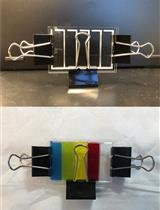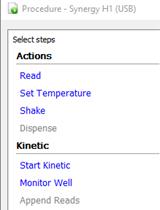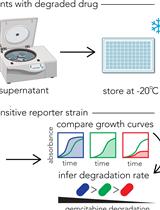- Submit a Protocol
- Receive Our Alerts
- EN
- EN - English
- CN - 中文
- Protocols
- Articles and Issues
- For Authors
- About
- Become a Reviewer
- EN - English
- CN - 中文
- Home
- Protocols
- Articles and Issues
- For Authors
- About
- Become a Reviewer
Induction of Tigecycline Resistance in Acinetobacter baumannii
Published: Vol 4, Iss 23, Dec 5, 2014 DOI: 10.21769/BioProtoc.1307 Views: 8190
Reviewed by: Arsalan DaudiKanika GeraAnonymous reviewer(s)

Protocol Collections
Comprehensive collections of detailed, peer-reviewed protocols focusing on specific topics
Related protocols

ODELAM: Rapid Sequence-independent Detection of Drug Resistance in Mycobacterium tuberculosis Isolates
Thurston Herricks [...] John D. Aitchison
May 20, 2021 3027 Views

Bacterial Growth Curve Measurements with a Multimode Microplate Reader
Ariel T. Rogers [...] Yong Wang
May 5, 2022 4373 Views

Functional Assay for Measuring Bacterial Degradation of Gemcitabine Chemotherapy
Serkan Sayin and Amir Mitchell
Sep 5, 2023 263 Views
Abstract
Multidrug resistance Acinetobacter baumannii (A. baumannii) (MDRAB) has emerged as a serious threat in hospitals in recent years. Currently, there are few antibiotics, including tigecycline, available to treat infections caused by MDRAB effectively. Both tigecycline-resistant and tigecycline-susceptible isogenic strains of MDRAB are valuable in understanding the mechanisms underlying tigecycline resistance. To get the isogenic strains in the laboratory, we describe a protocol for induction of tigecycline resistance in A. buamannii by serial passage to plates with tigecycline of different concentrations. The minimal inhibitory concentration of A. baumannii by tigecycline was determined according to the protocol “Minimal Inhibitory Concentration (MIC) Assay for Acinetobacter baumannii” (Lin et al., 2014b).
Keywords: Acinetobacter baumanniiMaterials and Reagents
- A. baumannii (ATCC, catalog number: 17978 )
- Tigecycline (Wyeth, catalog number. 0220620-09-7 )
- Tryptone (Pronadisa, catalog number: 1612 )
- Yeast extract (Pronadisa, catalog number: 1702 )
- NaCl (MDBio, catalog number: 101-1647-14-5 )
- 99% glycerol (Honeywell International, Riedel-deHaen, catalog number: 5523 )
- Lysogeny broth (LB) (see Recipes)
- 20% glycerol (see Recipes)
Equipment
- 50 ml polystyrene culture tubes (sterile)
- 37 °C shaking and static incubators
- Multichannel pipette (volume ranges 10 μl-1,000 μl)
Procedure
- Fetch the A. baumannii ATCC 17978 stock stored at -80 °C, scrape the surface of the frozen stock, and plate it on a LB agar.
- Put the LB agar in the 37 °C incubator overnight.
- Dissolve a single colony of A. baumannii from the overnight culture in 3 ml LB broth and incubate overnight at 37 °C, 220 rpm.
- On day 1, 3 ml of LB broth containing tigecycline at the MIC, which is determined by the protocol “Minimal Inhibitory Concentration (MIC) Assay for Acinetobacter baumannii” (Lin et al., 2014b), is inoculated with 30 μl broth containing A. baumannii (step 1), and the cultures are incubated at 37 °C with shaking (220 rpm) overnight.
Note: The choice of the volumes 30 μl and 3 ml is aimed to keep 1:100 dilutions. If other volumes or dilution ratios are used, it may lead to the change of tigecycline resistance induction time.
- On day 3, 30 μl of the culture is transferred to 3 ml of LB broth containing tigecycline at 8x MIC (step 2), and the cultures are again incubated at 37 °C with shaking (220 rpm). If no bacterial growth is noted from step 1, lower the tigecycline concentration to half of the 8x MIC, then repeat step 1.
- On day 5, 30 μl of the culture is transferred into LB broth containing tigecycline at 16x MIC (step 3), and the cultures are again incubated at 37 °C with shaking (220 rpm).
- This passaging is repeated on day 7 (step 4).
- On day 9, aliquots (0.5 ml) of the cultures are mixed with 0.5 ml 20% glycerol and stored at -80 °C until use.
- Daily passaging in tigecycline-free LB is conducted for 30 days after the tigecycline resistant strain is obtained to make sure the induction of tigecycline resistance is successful and long-lasting.
Recipes
- LB
10 g tryptone
5 g yeast extract
5 g NaCl
Fill to 1 L with ddH2O
Sterilized by autoclaving at 121 °C for 15 min
- 20% glycerol
20 ml 99% glycerol fill to 100 ml with ddH2O
Sterilized by autoclaving at 121 °C for 15 min
Acknowledgments
The development of this protocol was funded by a grant from the National Taiwan University Hospital, Chu-Tung Branch.
References
- Lin, M. F., Lin, Y. Y., Yeh, H. W. and Lan, C. Y. (2014a). Role of the BaeSR two-component system in the regulation of Acinetobacter baumannii adeAB genes and its correlation with tigecycline susceptibility. BMC Microbiol 14: 119.
- Lin, M., Lin, Y. and Lan, C. (2014b). Minimal inhibitory concentration (MIC) assay for Acinetobacter baumannii. Bio-protocol 4(23): e1308.
Article Information
Copyright
© 2014 The Authors; exclusive licensee Bio-protocol LLC.
How to cite
Lin, M., Lin, Y. and Lan, C. (2014). Induction of Tigecycline Resistance in Acinetobacter baumannii. Bio-protocol 4(23): e1307. DOI: 10.21769/BioProtoc.1307.
Category
Microbiology > Antimicrobial assay > Antibacterial assay
Cell Biology > Cell isolation and culture > Cell growth
Do you have any questions about this protocol?
Post your question to gather feedback from the community. We will also invite the authors of this article to respond.
Tips for asking effective questions
+ Description
Write a detailed description. Include all information that will help others answer your question including experimental processes, conditions, and relevant images.
Share
Bluesky
X
Copy link








